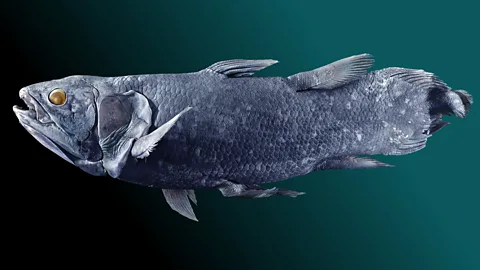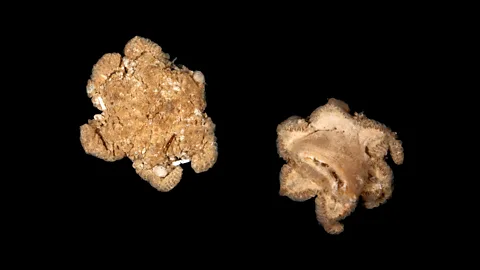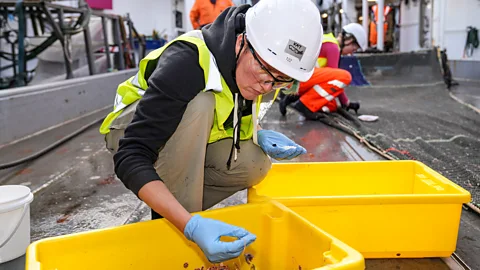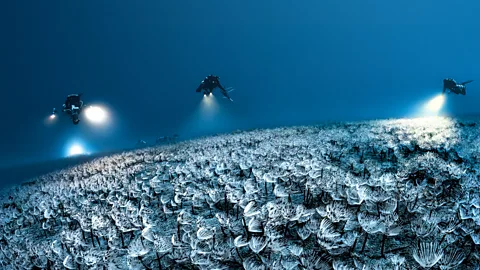


FAST DOWNLOAD
Scientists are racing to trace deep ocean species before they are lost, with the help of photographers who have a taste for danger.
In 2010 four friends, carrying 32kg (71lb) worth of camera equipment, sunk beneath the waves of Sodwana Bay, off the east coast of South Africa. It was then that photographer, Laurent Ballesta stared directly into the eyes of a creature once thought to have died out with the dinosaurs – and took the first ever photograph of a living coelacanth.
“It’s not just a fish we thought was extinct,” says Ballesta. “It’s a masterpiece in the history of evolution.”
Venture back to the beginning of the age of the dinosaurs, and you’d find coelacanths in abundance, on every continent, living in the steamy marshes of the Triassic Period. Dating back 410 million years, the coelacanth belongs to the group of “lobe-finned” fish that left the ocean between about 390 and 360 million years ago. Its strong, fleshy fins were a precursor to the paired limbs of tetrapods, which include all land-living vertebrates – amphibians, reptiles, birds and mammals and, yes, humans too. In fact, coelacanths are more closely related to tetrapods than to any other known fish species.
The youngest known fossil coelacanth is 66 million years old, leading to the assumption that these animals were long extinct. Then, in 1938, a fish with iridescent blue-green scales and four limb-like fins, was caught in a trawl net off the coast of South Africa. This coelacanth was dubbed a living fossil. Although, experts say this nickname is not accurate and the coelacanth has, in fact, evolved, albeit extremely slowly. For one thing, this elusive fish no longer dwells on the periphery of the land, but deep in the ocean.
“Every time they were caught, it was very deep, too deep for normal scuba diving techniques at the time,” says Ballesta. “So, it was just a fantasy in my mind.” But, in 2000, Ballesta heard about a diver named Peter Timm. “During a deep dive, Timm found a coelacanth in a cave at only 120m (393ft) [depth].” So, in 2010, after intensive deep-dive training, and with the help of newly available rebreather diving technology – which would allow him to remain underwater for longer than previously possible – Ballesta enlisted Timm to be his guide.
Coelacanths live in the benthic zone – on the sea floor – as deep as 300m (984ft) along steep underwater slopes and shelves. During the day, they gather in submarine caves, only emerging to feed during the night. It was in such caves, that Ballesta met his first coelacanth.

“[It is a] very rough coast: a lot of swell, waves, currents – and sharks,” says Ballesta. “It could be possible to die.” And others have died attempting to capture this elusive fish on film. However, even as a boy, Ballesta had a desire to push the limits of ocean exploration. “To go deeper, for longer, to explore,” he says. It was this drive that led Ballesta to become a marine biologist, explorer, pioneering deep diver and multi-award-winning underwater photographer.
So, why take the risk? Remote operated vehicles (ROVs), says Ballesta, are slow and unstable compared to a human diver. While Ballesta and his dive team were able to check all the submarine caves in about 12 minutes, an ROV took four hours. “It was not able to go inside the cave, to look up, to look down, to look round the corner,” says Ballesta. “Of course, if it was 1,000m (3,281ft) [down], or 6,000m (19,685ft), I cannot go. Nobody can. But when you are in the twilight zone, from 200m (656ft), we are much more efficient.”
In the first minute of the first dive, “I was in front of the coelacanth”, says Ballesta. The difficulty, he adds, was not to find the coelacanth, but to “reach its universe”.
“It wasn’t curious, but it wasn’t scared,” he says. After approaching the coelacanth to encourage it to move between two cameras positioned on a custom-made stand, the team turned on the lights. “At this depth, some think that there is no light,” says Ballesta. “There is [very] nice light. It’s tiny, it’s soft, but there is still light. So, it’s important to not use too much artificial light. It’s like driving in a car at night. If you put your lights on full, you see just in front of the car, and all the rest is dark. If you switch off your lights – and there is a little bit of moon – suddenly you see everything: the road, the mountains, the forest. It’s the same when you’re deep.”
In 2013, Ballesta and his team returned and encountered multiple coelacanths, spending up to half an hour in their presence. Ballesta’s dream, he says, is to return to the coelacanths with a subsea station, “to spend a full day and night with them at the bottom”.

Understanding the world’s oceans are a step towards protecting them, says Jessica Gordon, a marine scientist at the University of Essex in the UK. The ocean covers over 70% of the Earth’s surface, and contains 97% of all the water on the planet. Roughly half of all oxygen produced on Earth comes from the ocean, and it helps regulate our climate by absorbing over a quarter of human-caused carbon dioxide (CO2) emissions and around 90% of excess heat.
The ocean also represents 99% of all habitable space on the planet, making it the biggest ecosystem on Earth. Despite this, more than three quarters remains unmapped and unexplored, and an estimated 91% of ocean species have yet to be classified. (Read more about the search for the last ocean giants.)
“We know so little about the deep sea,” says Gordon, who recently took part in an expedition led by global scientific programme, Ocean Census. The team explored previously unmapped areas of the seafloor off the coast of New Zealand and discovered over 100 new species of deep-sea organisms including fish, squid, molluscs and coral.
Without knowing what’s there, we could destroy areas that we have no idea are absolutely full of life – Jessica Gordon
Corals are in trouble and without them, says Gordon, the whole food web would be destroyed. But, she adds, there are some species of coral that are “more adaptable to ocean acidification and climate change” than others.
“We can take cross sections of the main stem of a coral specimen – they have rings similar to a tree – and analyse each growth ring to get a record of the temperature and water chemistry at the time,” she says. “So, you can use both fossilised coral that that are thousands of years old, to determine what the sea was like thousands of years ago, and [you can look at] how they’re adapting to climate change now. Finding species that are able to adapt and grow in difficult conditions, is going to be essential to their survivability in the future.”
More like this
- The final frontier? How humans could live underwater in ‘ocean stations’
- Boops, hums and farts: The mysterious world of fish communication
- The new shark species emerging from the deep
And, as the number of species in the ocean decreases, understanding marine life and habitats is more important than ever, say experts, if we are to “halt the biodiversity crisis”.
“Such a small percentage of the sea is protected,” says Gordon. “And without knowing what’s there, we could destroy areas that we have no idea are absolutely full of life – essential to the ecosystem and to the functioning of the seas. We’ll never know what we could have saved.”

The coelacanth is “iconic”, says Emma Bernard, curator of fossil fish at London’s Natural History Museum (NHM). Every fossil is a piece of the puzzle that tells the story of evolution – but to see one come to life, “it’s amazing”, she says. “You can compare the fossil to the modern day coelacanth. You can almost match it bone to bone, see how it moves.”
And, while fossils and specimens can teach us a lot, they don’t tell the whole story, says James Maclaine, NHM’s curator of fish. “You can make reasonable assumptions – but sometimes there’s stuff you just would not expect.” he says. Take pelican eels, he says. “It’s a long thin fish, with a big bag-like mouth, a bit like a pelican’s mouth. Looking at the specimen, you could think ‘that’s for feeding’. But it does this other thing which nobody suspected. [Scientists] found one alive, swimming around thousands of metres down, and as the submersible approached it inflated its head like balloon – to make itself look more intimidating.”
What does it take to be a truly great ocean photographer? Danger, says Ballesta
Thanks to Ballesta’s work, we now know the coelacanth is among the longest-living fish species, with a lifespan of around 100 years, and has one of the slowest life histories of all marine fish – so, like deep-sea sharks with a reduced metabolism, the coelacanth grows slowly, taking as long as 69 years to reach sexual maturity, and with a gestation period of around five years.
Life deep in the sea, happens slowly, says Maclaine. “As you go deeper and deeper, the deep sea becomes more and more stable, cushioned from environmental changes above. There are no mad fluctuations – and things tend to be very slow growing, and live very long lives,” he says. The stability of the deep sea environment may help to explain why the coelacanth survived the mass extinction that wiped out the dinosaurs. “But it’s also a very fragile [environment]. If you disturb it in anyway, it can take hundreds of years to recover.”
Long-lived species, with slow life histories, are especially vulnerable to natural and anthropogenic stressors, suggesting that coelacanths may be more threatened than previously considered. And it is only by observing these creatures in their own habitat that we can really begin to understand them.

But what does it take to be a truly great ocean photographer? Danger, says Ballesta. “I realised that every time [a dive] is easy, my photos are not good,” he says. “I need to feel I’m in an uncomfortable situation to give my best. If you put me in the Red Sea in 20m (66ft) of warm water – I don’t take better images than others.” In an extreme situation on the other hand – one in which he feels he shouldn’t be allowed, that his time is limited, there is an urgency – a switch flicks.
“Suddenly to witness the animals, the ecosystem, everything around you. You’re not in your world. You’re just allowed to stay here for a couple of minutes, so [you’ve got to] make the best of the situation. I forget everything else. I’m living the moment. I stay focused and I make my best images.” That’s how it was with the coelacanth, he says. Only afterwards, on the long slow ascent, did Ballesta allow himself to feel joy and pride in what he and his team had achieved.
The coelacanth expedition was a springboard for Ballesta’s exploration career. In 2019, Ballesta, together with three other divers, lived in a saturation chamber on a floating barge which was pressurised to the equivalent of -120m (-394ft) depth. “For 28 days, we lived enclosed in this very small yellow box without windows. You have to really know your friends when you do something like that,” he says. Find out more about Ballesta’s Mediterranean expedition in the video below.
During this expedition Ballesta pioneered a new diving technique, combining the saturation diving used by commercial offshore divers at the time, with autonomous diving. A diving bell was connected to the saturation chamber, which would allow commercial divers to descend to great depths to undertake underwater construction work. These divers would remain connected to the chamber while carrying out this work.
Ballesta, on the other hand, used an electronically managed rebreather to leave the bell for autonomous deep sea exploration – making him the first person to take what could be described as an untethered space walk deep under the ocean. Every day, Ballesta’s team went out to explore and study the twilight zone, from Marseille to Monaco, illustrating the deep ecosystems of the Mediterranean.
Ballesta is a rare breed, both an artist and a scientist. It’s this coalescence that allows his work to capture both scientific data and, at the same time, act as a window into the unknown – one that we can all look through. “I want to tell a story,” he says. “This story is a natural history, a story of biodiversity. But it’s also our story.”





















































